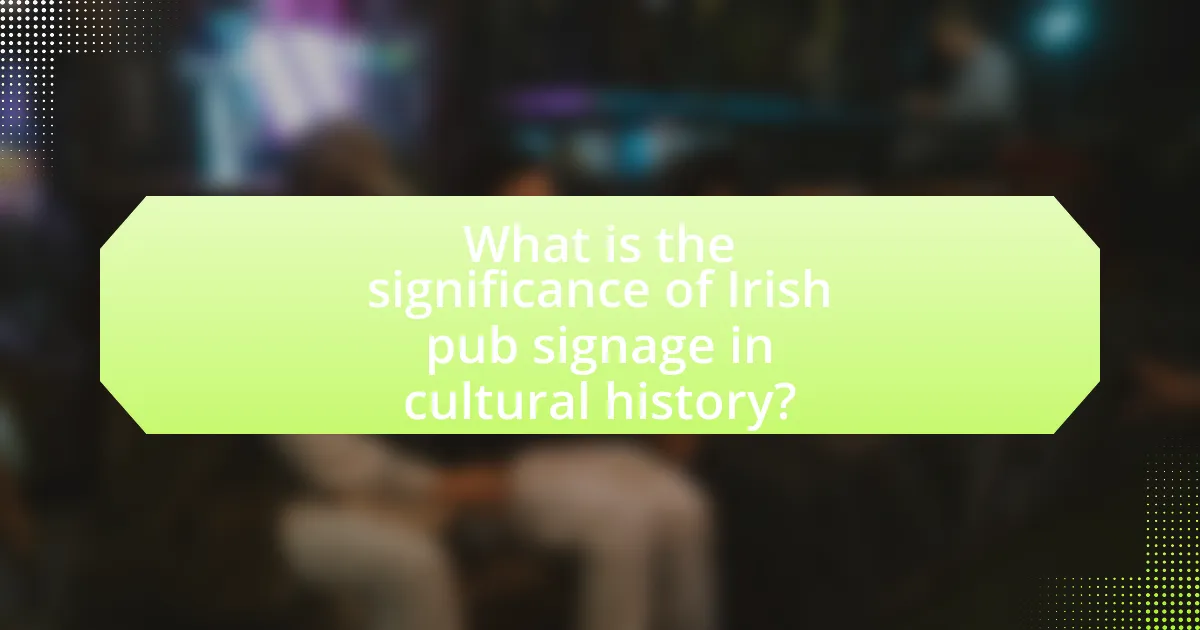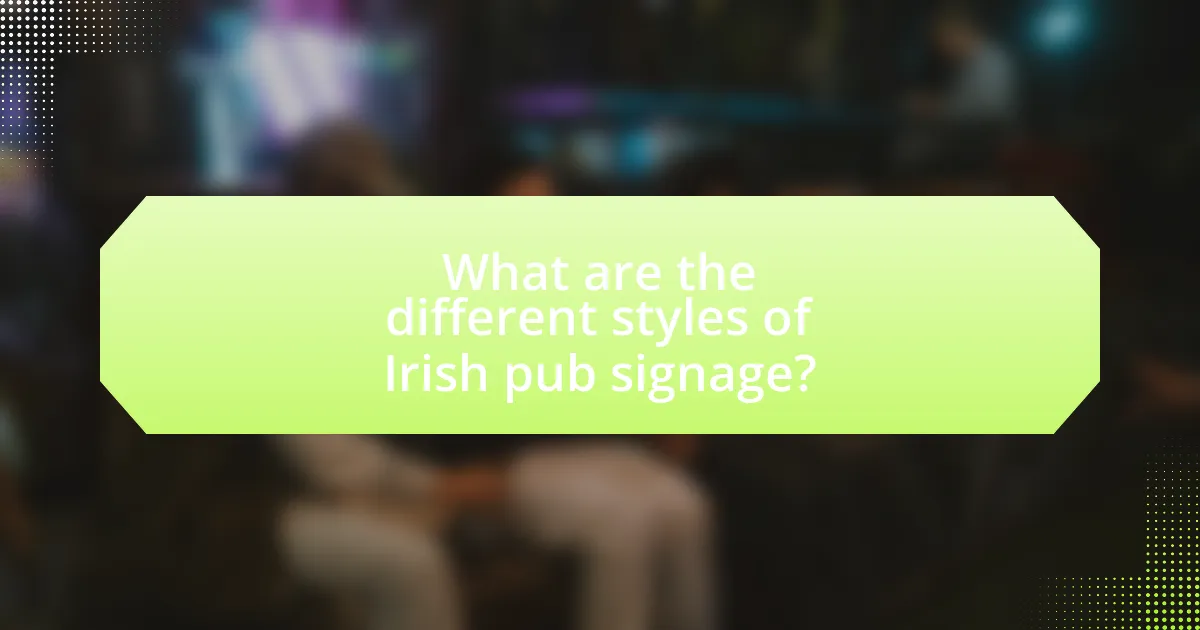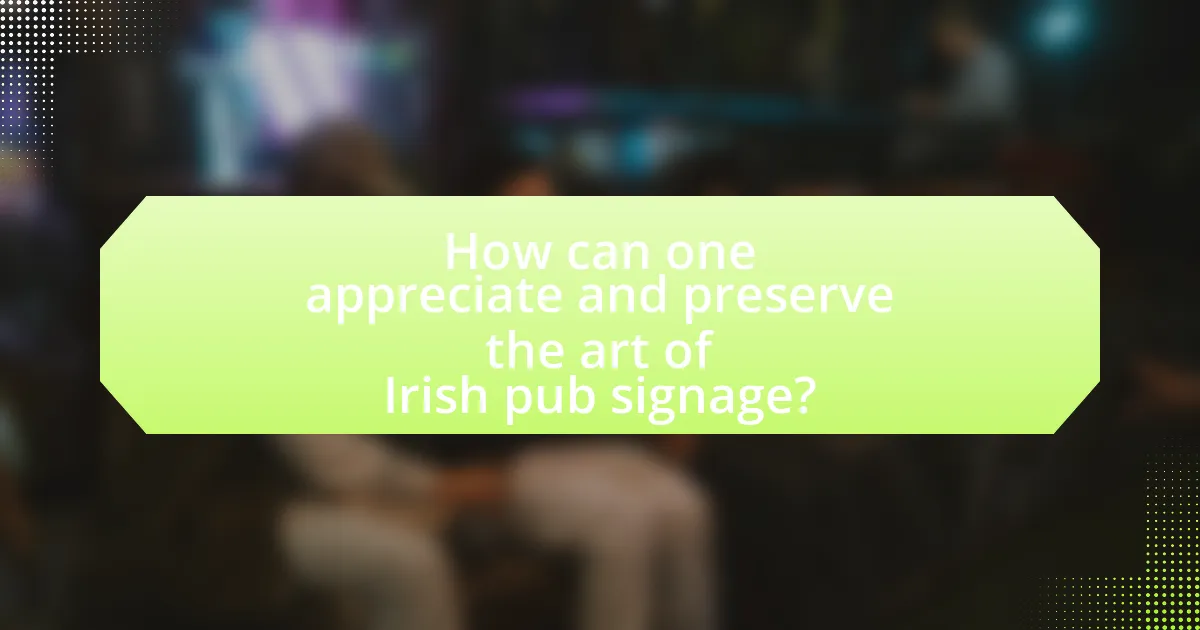The article focuses on the significance of Irish pub signage, highlighting its cultural, historical, and artistic importance in Ireland. It explores the evolution of pub signs from simple wooden boards to intricate modern displays, influenced by historical events and technological advancements. The article examines the role of symbols, colors, and typography in conveying cultural identity and branding, as well as the craftsmanship involved in traditional and contemporary signage. Additionally, it discusses best practices for maintaining and preserving these signs, emphasizing their value in representing community heritage and attracting patrons.

What is the significance of Irish pub signage in cultural history?
Irish pub signage holds significant cultural importance as it reflects the social, historical, and artistic heritage of Ireland. These signs often feature traditional Gaelic language, local folklore, and unique artistic styles, serving as a visual representation of community identity and pride. Historically, the use of pub signage dates back to the 17th century, when pubs became central social hubs in Irish towns, and the signs helped to attract patrons and convey the character of the establishment. The craftsmanship involved in creating these signs showcases local artisanship, contributing to the preservation of cultural traditions. Additionally, the imagery and text on these signs often tell stories of local history and mythology, reinforcing the connection between the pub and its surrounding community.
How has Irish pub signage evolved over the centuries?
Irish pub signage has evolved significantly over the centuries, transitioning from simple wooden boards to intricate, artistic displays. Initially, in the 17th and 18th centuries, signage primarily consisted of basic painted wooden signs that indicated the establishment’s name, often featuring symbols like a harp or a shamrock to convey Irish identity. As the 19th century progressed, the introduction of glass and metal allowed for more elaborate designs, incorporating vibrant colors and detailed imagery, reflecting the growing importance of branding in the pub industry. By the 20th century, neon signs and illuminated displays became popular, further enhancing visibility and attracting patrons. This evolution mirrors broader trends in advertising and consumer culture, showcasing the significance of visual identity in the hospitality sector.
What historical events influenced the design of Irish pub signs?
The design of Irish pub signs has been influenced by several historical events, notably the Gaelic revival in the late 19th century, which emphasized Irish culture and language, leading to the incorporation of Gaelic script and imagery in signage. Additionally, the rise of the temperance movement in the early 20th century prompted some pubs to adopt more subdued designs to appeal to a broader audience. The impact of the Irish War of Independence (1919-1921) and subsequent civil war also led to a surge in nationalistic themes in pub signage, reflecting a sense of identity and pride. These events collectively shaped the visual language of Irish pub signs, making them a unique representation of Ireland’s cultural and historical narrative.
How did the craftsmanship of signage change with technological advancements?
The craftsmanship of signage evolved significantly with technological advancements, transitioning from hand-painted techniques to digital printing methods. Historically, artisans meticulously crafted signs using traditional materials like wood and metal, employing skills such as carving and painting. However, the introduction of computer-aided design (CAD) and digital printing technology in the late 20th century revolutionized the process, allowing for faster production, greater precision, and the ability to create complex designs that were previously labor-intensive. For instance, the use of vinyl graphics and LED lighting has enabled more vibrant and eye-catching signage, enhancing visibility and appeal. This shift not only streamlined production but also expanded the creative possibilities for sign makers, leading to a more diverse range of styles and applications in the signage industry.
Why are symbols and imagery important in Irish pub signage?
Symbols and imagery are crucial in Irish pub signage because they convey cultural identity and attract patrons. The use of recognizable symbols, such as shamrocks or harps, connects the establishment to Irish heritage, fostering a sense of community and tradition. Additionally, imagery serves as a visual cue that communicates the pub’s atmosphere and offerings, enhancing the overall customer experience. Historical evidence shows that pubs have utilized distinct symbols for centuries, making them easily identifiable and memorable in a competitive market. This practice not only honors Irish culture but also plays a significant role in marketing and branding within the hospitality industry.
What common symbols are found in Irish pub signage and what do they represent?
Common symbols found in Irish pub signage include the harp, shamrock, and Celtic cross. The harp represents Ireland’s rich musical heritage and is a national symbol, reflecting the cultural significance of music in Irish society. The shamrock symbolizes Irish identity and is associated with St. Patrick, who used it to explain the Holy Trinity, thus representing faith and national pride. The Celtic cross signifies the blend of Christianity and Celtic culture, highlighting the historical and spiritual connection of the Irish people to their land and heritage. These symbols collectively convey themes of national identity, cultural pride, and historical significance in Irish pub signage.
How do colors and typography contribute to the identity of Irish pubs?
Colors and typography significantly shape the identity of Irish pubs by evoking cultural heritage and creating a welcoming atmosphere. The use of deep greens, rich browns, and warm golds in color schemes reflects Ireland’s lush landscapes and traditional craftsmanship, fostering a sense of place and authenticity. Typography often features Gaelic script or bold serif fonts, which not only enhance readability but also connect patrons to Ireland’s linguistic history and artistic traditions. For instance, the iconic use of the Irish tricolor in signage reinforces national pride and cultural identity. This combination of color and typography not only attracts customers but also communicates the pub’s character, making it a vital aspect of the overall experience.

What are the different styles of Irish pub signage?
Irish pub signage encompasses various styles, including traditional hand-painted signs, illuminated signs, and modern digital displays. Traditional hand-painted signs often feature intricate designs and calligraphy, reflecting the craftsmanship of local artisans and the pub’s heritage. Illuminated signs, commonly found in urban areas, use neon or LED lighting to attract attention, while modern digital displays offer dynamic content and can be easily updated. Each style serves to convey the pub’s identity and atmosphere, contributing to the overall cultural landscape of Irish hospitality.
How do traditional and modern styles differ in Irish pub signage?
Traditional Irish pub signage typically features ornate, hand-painted designs with intricate lettering and imagery that reflect local culture and history, often using wood or metal materials. In contrast, modern Irish pub signage tends to adopt a minimalist aesthetic, utilizing bold fonts, digital printing techniques, and simpler graphics, which prioritize visibility and brand recognition. The shift from traditional to modern styles can be attributed to changing consumer preferences and advancements in technology, leading to a more streamlined and commercial approach in contemporary signage.
What materials are typically used in traditional Irish pub signs?
Traditional Irish pub signs are typically made from wood, metal, and glass. Wood is often used for its durability and ability to be intricately carved, while metal, particularly wrought iron, is favored for its strength and decorative potential. Glass is commonly employed for painted or etched designs, adding an elegant touch to the signage. These materials have been historically significant in Irish pub culture, with wooden signs dating back centuries, reflecting the craftsmanship and artistry of local artisans.
How do modern designs reflect contemporary Irish culture?
Modern designs reflect contemporary Irish culture by incorporating traditional motifs, vibrant colors, and local materials that resonate with Ireland’s rich heritage. For instance, the use of Celtic patterns and symbols in pub signage connects to Ireland’s historical identity, while contemporary typography and design techniques showcase a blend of innovation and tradition. This fusion is evident in the signage of popular pubs, where modern aesthetics meet cultural storytelling, creating an inviting atmosphere that appeals to both locals and tourists. The emphasis on craftsmanship and authenticity in these designs further highlights the importance of cultural pride in contemporary Irish society.
What role does signage play in the branding of Irish pubs?
Signage plays a crucial role in the branding of Irish pubs by serving as a visual representation of their identity and atmosphere. Effective signage communicates the pub’s theme, heritage, and values, often incorporating traditional Irish symbols and typography that resonate with cultural significance. For instance, many Irish pubs utilize Gaelic language and imagery associated with Irish folklore, which enhances their authenticity and appeal to both locals and tourists. This strategic use of signage not only attracts customers but also fosters a sense of community and belonging, reinforcing the pub’s brand as a gathering place.
How can effective signage attract customers to a pub?
Effective signage attracts customers to a pub by clearly communicating the pub’s identity, offerings, and atmosphere. Well-designed signs can capture attention through vibrant colors, unique fonts, and engaging graphics, making the pub stand out in a competitive environment. Research indicates that 76% of consumers have entered a business they had never visited before based solely on its signage, highlighting its importance in driving foot traffic. Additionally, effective signage can convey promotions, events, or special features, further enticing potential customers to enter.
What are some examples of successful branding through pub signage?
Successful branding through pub signage is exemplified by iconic establishments like The Guinness Storehouse in Dublin, which utilizes its distinctive harp logo and bold colors to create a recognizable identity. Another example is The Temple Bar pub, known for its vibrant red exterior and traditional Irish motifs, effectively attracting tourists and locals alike. Additionally, The Brazen Head, Ireland’s oldest pub, employs historical imagery and classic typography to convey authenticity and heritage, reinforcing its brand as a traditional Irish pub. These examples demonstrate how effective signage can enhance brand recognition and customer engagement in the competitive pub industry.

How can one appreciate and preserve the art of Irish pub signage?
One can appreciate and preserve the art of Irish pub signage by recognizing its cultural significance and supporting traditional craftsmanship. Irish pub signage often reflects local history, community identity, and artistic styles, making it an important aspect of Ireland’s cultural heritage. To preserve this art form, individuals can engage with local artisans who specialize in hand-painted signs, ensuring that traditional techniques are passed down through generations. Additionally, participating in workshops or exhibitions dedicated to pub signage can enhance appreciation and awareness of its artistic value. Supporting local pubs that maintain authentic signage also contributes to the preservation of this unique art form, as these establishments often serve as cultural landmarks.
What are the best practices for maintaining traditional pub signs?
The best practices for maintaining traditional pub signs include regular cleaning, protective coatings, and timely repairs. Regular cleaning prevents dirt and grime buildup, which can obscure the sign’s visibility and aesthetic appeal. Using a soft cloth and mild soap ensures that the paint and materials are not damaged. Applying protective coatings, such as varnish or sealants, helps shield the sign from weather elements, UV rays, and fading, thereby extending its lifespan. Timely repairs, including repainting or fixing structural issues, are crucial to preserving the sign’s integrity and historical value, as neglect can lead to irreversible damage. These practices are essential for maintaining the cultural significance and visual impact of traditional pub signage.
How can communities support the preservation of historical signage?
Communities can support the preservation of historical signage by organizing local initiatives that focus on restoration and maintenance efforts. These initiatives can include fundraising campaigns to finance restoration projects, educational programs to raise awareness about the cultural significance of historical signage, and partnerships with local businesses and historical societies to ensure proper care and preservation techniques are employed. For instance, cities like Dublin have implemented community-led projects that successfully restored iconic pub signs, highlighting the importance of collective action in preserving local heritage.
What tips can be applied for creating effective pub signage today?
To create effective pub signage today, focus on clarity, visual appeal, and relevance to the target audience. Clear messaging ensures that patrons can quickly understand the offerings, while visually appealing designs attract attention and convey the pub’s atmosphere. Incorporating local culture or themes can enhance relevance, making the signage resonate with the community. For instance, studies show that well-designed signage can increase foot traffic by up to 20%, highlighting the importance of effective visual communication in attracting customers.
How can pub owners balance tradition and modernity in their signage?
Pub owners can balance tradition and modernity in their signage by incorporating classic design elements while utilizing contemporary materials and technology. For instance, they can use traditional fonts and imagery that reflect the pub’s heritage, such as Celtic designs or historical references, while employing modern lighting techniques or digital displays to attract attention. This approach not only honors the pub’s history but also appeals to a modern audience, as evidenced by the increasing trend of pubs that successfully blend vintage aesthetics with innovative features, enhancing both the visual appeal and functionality of their signage.
What common mistakes should be avoided when designing pub signs?
Common mistakes to avoid when designing pub signs include using overly complex fonts, which can hinder readability, and neglecting to consider the sign’s visibility from a distance. Research indicates that signs with clear, bold typography are more effective in attracting customers, as they can be read quickly while passing by. Additionally, failing to incorporate the pub’s branding elements, such as colors and logos, can lead to a lack of identity, making it difficult for potential patrons to recognize the establishment. A study by the Sign Research Foundation highlights that consistent branding across signage increases customer recognition by up to 80%. Lastly, overcrowding the sign with too much information can overwhelm viewers, reducing the likelihood of them engaging with the content.
